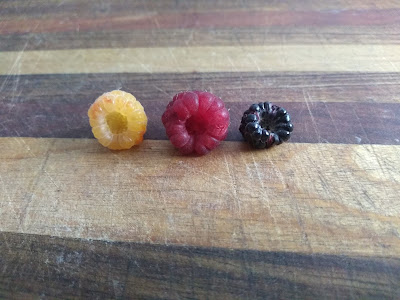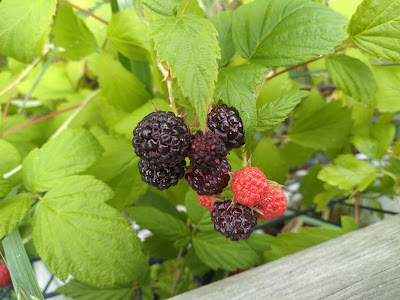A mulberry tree is like a vegetable garden on a trunk.
Mulberry trees are well known for producing delicious berries. What many people do not realise is that mulberry trees also produce abundant and surprisingly nutritious leafy greens.
I have cooked and eaten mulberry leaves, they taste nice and can be used like spinach or silverbeet. I have only cooked eaten young leaves. I imagine older leaves would be too fibrous and I can't imagine raw leaves to taste all that nice.
 |
| Mulberry leaf as a vegetable |
While there is little mention of them on the internet, mulberry leaves are eaten as a vegetable in several places such as Cuba and Latin America.
Mulberry trees produce well with little (or no) irrigation, can thrive in many climates from frosty temperate areas to the tropics, thrive on many different soil types, they have few significant pests, and they produce well on many different soil types. Mulberries are remarkable trees that are drastically underutilised for food security, they are excellent fodder for livestock, and are a great vegetable for people.
The taste of cooked mulberry leaves is ok, not bitter or objectionable, but also not remarkable. I have started to see people sharing recipes using mulberry leaves to wrap lamb or chicken or rice or tofu, similar to how people use grape leaves. Given how nutritious and abundant they are I think mulberry leaves deserve to be eaten more commonly.
 |
| Stuffed mulberry leaves - image from https://maryamsculinarywonders.blogspot.com/2019/04/1234-freekeh-stuffed-mulberry-leaves.html |
Mulberry leaves typically contain more than triple the amount of protein found in many vegetables, and under normal circumstances mulberry trees can produce up to double the amount of protein per acre compared to soy.
If you don't already have a mulberry tree, you should consider growing one. Mulberry trees are one of the simplest fruit trees to grow, they grow very fast, and mulberry leaf is the easiest vegetable for beginners to grow and the most productive vegetable for beginners to grow.
 |
| Cutting grown mulberry tree |
A study was undertaken comparing the nutritional value of fresh leaves from six different genotypes of mulberry. Even though there is a bit of a range of values between cultivars it demonstrates that mulberry leaves are far more nutritious than most vegetables we commonly eat.
I have summarised their findings below:
- Moisture 71.13 to 76.68%
- Protein 4.72 to 9.96% (most vegetables have about 2% or less)
- Ash 4.26 to 5.32% (ash is the mineral content: calcium, phosphorus, magnesium, zinc, etc)
- Neutral Detergent Fiber 8.15 to 11.32%
- Fat 0.64 to 1.51%
- Carbohydrates 8.01 to 13.42%
- Energy 69 to 86 kcal/100 g
- Vitamin C 160 to 280 mg/100 g (oranges have 50 mg)
- Beta-carotene 10,000 to 14,688 mcg/100 g (carrots have 8,729 mcg)
- Iron 4.70-10.36 mg/100 g (spinach has 2.6 mg)
- Zinc 0.22-1.12 mg/100 g
- Calcium 380-786 mg/100 g (full fat cow milk has about 120 mg)
Recently a desktop review was conducted comparing several options for households producing all their own protein when there are future disruptions to supply chains. Their conclusions were unrealistic at best, but they made me think about back yard food production.
We have a good size vegetable garden, but it is nowhere near large enough to supply our household with all our protein requirements. We also have a few egg laying chickens, and some fruit trees, including a white mulberry (Morus alba) and a white shahtoot mulberry.
Following on from the growing protein study linked to above, and given how nutritious mulberry leaves are, I wondered how many mulberry trees I would need to produce all my protein for a year. So, out of curiosity I crunched some numbers similar to the desktop review. The results were interesting.
 |
| Mulberry leaf stuffed with chicken - image from https://www.greenprophet.com/2013/05/stuffed-mulberry-leaves-recipe/ |
A lot of research has been conducted into mulberry tree leaves as they (mulberry leaves, not the berries) are commercially important due to silkworm farming. I used this research to work out how much protein a mulberry tree can produce, and how many trees would be required for a year supply of protein.
Often, about 9,600 mulberry trees are grown per hectare or almost 4,000 per acre, this works out to just under one per sqm. Yields of fresh leaves range from 3.2–21 tons/acre/year (8–52 tons/hectare/year) with most in the 8–12 tons/acre/year (20–30 tons/hectare/year). This means that on average, each year roughly 2.5kg of leaves are harvested per mulberry tree.
The protein in mulberry leaves ranges from 15-35% dry weight, or 4.72-9.96% of the fresh weight. I used 6.5% for the protein content of fresh leaves in my calculations, which is lower than the average. That works out to 162.5 grams of protein per tree being produced from leaves alone, meaning a one year supply of protein for one person can be provided by the leaves harvested from approximately 112 mulberry trees.
 |
| Mulberry leaves are abundant vegetables |
Soy is a legume crop that is known for producing high amounts of protein per acre. Soy is said to produce up to 513,066 grams of protein per acre.
Around 4,000 mulberry trees are planted per acre, each yielding 2.5kg of leaves with 6.5% (or more) protein fresh weight. This produces over 650,000 g protein per acre, which is significantly more protein per acre than soy.
If growing a mulberry variety with 10% protein in fresh leaves it would produce double the amount of protein that soy can produce per acre. Mulberry trees produce more protein per acre than soy.
 |
| White mulberry tree outside my back fence |
Comparing the water requirements is a bit more difficult and far less accurate, so you have to take the following 'with a grain of salt'.
Not surprisingly, I could not find any publications directly comparing the water requirements of mulberry and soy. According to Agriculture Victoria (https://agriculture.vic.gov.au/crops-and-horticulture/grains-pulses-and-cereals/growing-grains-pulses-and-cereals/growing-soybean-in-victoria), soy requires an average of 2.6 Megaliters of water per acre. According to the Rural Industries Research and Development (https://agrifutures.com.au/wp-content/uploads/publications/00-056.pdf) mulberry tree plantations require less than 1.3 Megaliters per acre.
Using the above calculations it appears that mulberry trees could produce about double the amount of protein per acre compared to soy, while using half the irrigation. Mulberry trees can produce good amounts of protein per acre in marginal areas where soy will not produce any crop because the climate and soils and climate are not right for soy.
Who knew that mulberry leaves can produce that much much more protein per acre that soy!
 |
| Mulberry cutting |
Does all of this mean I am suggesting that people should grow 112 mulberry trees each to produce all their protein needs? Absolutely not.
Even though it would be really cool, replacing the lawn with an orchard of heavily coppiced mulberry trees isn’t something that people would want to do.
While growing this many mulberry trees may be possible in some yards, and would take less time and effort to look after than the average lawn of the same size, I don’t think it is realistic, and I'm not planning on doing that.
 |
| 10cm tall to 6 feet tall in under 5 months |
I can’t imagine what a miserable existence it would be having to eat about a kilogram of mulberry leaves each and every day to meet your protein requirements. I don't know what you would do over winter while the deciduous trees are leafless.
I am not suggesting you plant 2 or 3 mulberry trees, and eat nothing but mulberry leaves for a few weeks each year. I am also not suggesting that you should grow a mulberry and regularly incorporate its leaves in your meals over the growing months.
 |
| Mulberry leaf plantation. Image by Nahid Hossain, Creative Commons 4.0 license |
What I am suggesting is growing a mulberry tree, or several mulberry trees, is a good idea if you have the space. It will add to your food security even if you never eat the leaves.
The estimated leaf yields above are based on coppiced trees that are regularly harvested for silkworm production. When grown like this there are no berries, just leaves.
Most backyard mulberry trees would not grow like this, most would be allowed to produce berries and develop into large trees with a single trunk or as a multi trunked tree. As the trees grow larger, they produce increasing yields of both berries and leaves.
The FAO mentions very old trees in China producing 400kg of berries and 225kg of fresh leaves in a year. What an incredible sight they must be!
 |
| My mulberry producing food from otherwise unused land |
A mulberry tree would increase your food security. Each year you can eat some berries (they are utterly delicious), or you can grow the tree in your chicken run and let your chickens eat them, if your chickens eat all the berries you will save a little money on chicken feed and help your chickens be a little healthier. Or you can let the birds take care of them for you. From time to time the leaves can be eaten, or made into tea, or just left alone to allow the tree to gain energy and grow larger.
During times of financial hardship, you hear regular stories of vegetable gardens being raided and produce being stolen (and/or destroyed). While people would probably take some berries, it is unlikely during an emergency that your neighbours would take any leaves from your mulberry tree as they would not recognise them as being edible or as being high in protein and vitamins. This adds to your food security as you would have a tree full of leaves to cook if you ran low on everything else. You could use the leaves like spinach, except mulberry leaves are far more nutritious.
 |
| Fresh mulberry leaves can grow large |
Chickens and other small animals enjoy eating mulberry leaves. When hard times hit, you may be unable to buy food for chickens or other little animals . You certainly don't want them to starve. The mulberry tree can be used to reduce the amount of bought feed you are using, to get you through until you are able to buy animal feed again. This also adds to your food security.
Mulberry trees appear to be the ultimate perennial vegetable. Most people who have eaten the leaves cooked enjoyed them, some felt neutral about them, so far I have never met anyone who has disliked them. People tend not to eat mulberry leaves as a vegetable often due to the cultural taboo surrounding eating tree leaves. For some reason we have been told to view tree leaves as a famine food rather than a sustainable and easy to grow perennial vegetable. There is nothing wrong with eating healthy organic leaves from mulberry trees.
Having a nice-looking shade tree in your yard, that is able to provide you with delicious berries in season, and a few handfuls of vegetable leaves if needed, seems like a sensible thing to do. If you can get past the idea of tree leaves being famine food, all the better!














































